Here’s a secret: I don’t actually enjoy speculating on cards all that much.
I get emotional pretty easily, and the rush I get from a win never seems to balance out the frustration I get from a loss. I made more money on Spellskite than I lost on Whispering Madness, but I think about my mistake with the second card far more. I often wish there was a way to speculate on cards that was almost entirely risk free, even if it meant having to put in more time.
In a sense, this is the niche that is filled by collection flipping. Unlike speculation, which involves buying cards at retail and hoping for a rise in price, flipping a collection allows you to buy cards at a discount in exchange for buying in bulk. Because you don’t need to sweat out an external factor (the price of a card rising in value), it is much easier to mitigate risk while flipping collections. In fact, I’ve purchased a hundred or more collections in my lifetime, and I’m pretty sure I’ve only lost money on one of them.
Today, I’m going to share with you my collection flipping tips. Unlike some of my more theoretical articles, these techniques have made me thousands of dollars, and I see no reason why they wouldn’t work for everyone. You are only limited by how much time and effort you want to put into the endeavor.
The Great Collection Search
Finding a great collection to buy is a tough first step. Searching is a long and frustrating process that requires you to put yourself out there in a way that you might be uncomfortable with at first.
The first and easiest place to look for collections is on Craigslist. Three or four years ago, the site was a goldmine for finding underpriced collections. Of course, that was before the Magic finance boom happened, and I was one of only a handful of people in LA doing it. Nowadays, promising leads are snapped up in minutes, and you need to be faster than everyone else. I currently use an RSS feed of a search for “Magic cards” on the LA Craigslist that updates whenever a new listing goes up. There are also sites that will send you an email alert if you really want to get ahead of the game.
Of course, most of the collection listings that go up on Craigslist are rubbish. The bulk of them are either large lots of picked-over commons at ludicrous prices, Standard cards being sold at full retail, or stacks of Fourth Edition rares. With those collections, you are lucky to earn the privilege of buying one dual land at full retail as long as you’re also willing to pay retail or higher for multiple copies of Living Lands and Farmstead.
Avoid collections where it is clear someone used a site to price out every card they own, up to and including the bulk commons. This is usually a sign of someone unwilling to face reality about the value of their cards as well as someone hoping to extract every last nickel out of their Thorn Thallids. I would also avoid driving to see collections that are too new, as Standard prices are volatile and the margin for flipping these cards is too low unless you get an outstanding deal.
I also rarely travel for any collection shoebox-sized or smaller unless it looks like the cards are from Revised or earlier. Pawing through a shoebox of Ice Age or Odyssey cards might yield a couple of interesting finds, but when the seller realizes that you’re not going to be able to pay them the $80 or whatever they wanted for the whole box, you’ll probably walk away empty-handed. Stick to bigger or more promising lots.
There are two types of collections you should always be on the lookout for. The first is the larger “I don’t know what cards are here!” lot. Generally, this one is put up by someone who played a lot as a kid and hasn’t looked at their cards in eight or ten years. They might be able to identify some rares, but likely not all of them and certainly not the good commons or uncommons. This ex-player also probably doesn’t have a sense of which cards have gone up in price over the past few years. Obviously, every collection flipper out there is drooling to get their hands on these sorts of collections, so if you see an ad like this you should move fast.
The second type of worthwhile collection is more subtle but still just as profitable. This collection belongs to the frustrated grinder—someone who knows the true value of their cards but is looking to liquidate fast, usually because they fell behind on their rent or in order to help buy something big like a car or an engagement ring. These collections tend to sit on Craigslist a little longer because the seller clearly knows what a dual land is, but if you show up at their door with cash, you can do just as well here as you can buying from the clueless guy. These collections may have a smaller profit margin, but they are more likely to contain a critical mass of good, flippable cards.
If you get frustrated with the lack of good collection listings and want to get more aggressive, posting an ad on Craigslist yourself is a must. If you’re in a large metro area, you likely won’t be the only one with an ad offering cash for cards, but even if it only leads you to a couple of hits a year, it is probably worth your time. I did this briefly and ended up with three solid collections coming right to my door.
Beyond Craigslist, you can try to post ads in other places. If you are a regular on a non-Magic online forum where former Magic players like to hang out, see if there is an appropriate place to post an advertisement. Do you have a local comic store that doesn’t deal in Magic? Ask if you can put a flyer up on their bulletin board. Grocery store, library, and rec center bulletin boards might yield results as well. It’s also worth bringing up whenever you meet someone who looks like they might have played the game at one point or another and can steer the conversation in that direction. You’d be surprised who has a shoebox full of cards still stuffed under their childhood bed.
One word of caution: I strongly recommend against buying collections sight unseen. A year and a half ago I did an article on eBay collections where the contents were somewhat unknown and came to the realization that most of them were listed that way to deliberately entice foolish buyers. You should always assume that every unseen card is bulk, even if it seems promising. The risk isn’t worth the potential reward.
Remember the one collection I didn’t make money on? When I was younger and more inexperienced, I had been having terrific luck buying collections locally but had started to get frustrated with my inability to find more cards nearby. I was living in Boston without a car at the time, so I was limited to looking at collections up and down the MBTA. I came across a really great-looking collection on the Craigslist site for some small Midwestern city: 5,000 Urza’s Saga through Onslaught era cards for $100. The seller claimed they came straight out of packs because he never traded much. I talked to him over the phone, told him I’d pay for shipping, and made the deal sign unseen. When the box came, it had only a single rare: Verdeloth the Ancient. The rest was true bulk. Don’t buy collections you can’t verify beforehand.
Making the Buy
The most common type of collection buy will pit you against a seller with a limited or outdated knowledge of prices. Obviously, the transaction is easy if they give you a price on the collection and you can tell it’s great after looking at just a couple of cards. After all, if the collection costs $150 and you spot two copies of Underground Sea right off the bat, it doesn’t matter if every other card is a Chimney Imp. Close the deal, grab the cards, and book it.
Most of the time, however, it isn’t that easy. Either the price is much higher than you can pay, or the seller wants you to make them an offer. At this point, you’ll need to gauge what the seller’s reaction might be to you taking the time to sort through the entire collection. Some people just want the buyer to give them their $60 and leave. Others will want you to dig around in order to present them with the best possible deal. Figure out which situation you’re in before moving forward.
If the seller is impatient, ask them if they a binder or a stack of rares somewhere. If so, just focus on these when crafting your offer and worry about the commons and uncommons later. If there is no separate place for rares, try to paw through some of the cards at warp speed just so that you know what you’re in for before making an offer. If you see a couple of Wastelands, obviously you can offer a bit higher than if you haven’t come across a single rare.
If you’re buying a collection fairly blind, make the seller name their price first. Tell them you can’t make an offer yourself without looking through all the cards. Finding a fair deal in these cases takes some experience, but as long as you never pay for cards you don’t see, you’ll do just fine.
Even if you are allowed to look through all of the cards, you should still go as fast as you can. Don’t bother pulling out every Dark Ritual and Lightning Bolt—flip through the stacks quickly and focus on the cards you know sell for at least $2. Every seller loses patience after a while, and you should try to look through as many cards as possible before the seller just wants you gone. If you’re good at multitasking, ask the seller about their life and try to have a fun conversation while you pull—it makes the time go quicker. Once you have your whole stack pulled, it’s time to start negotiating.
There is almost always going to be a major expectations gap between buyer and seller, and your job is to see if that gap is possible to bridge. After all, the owner of the cards spent between $3 and $4 on each booster pack, so their collection likely represents hundreds or even thousands of dollars’ worth of their hobby money. If most of those packs were Fallen Empires or Ice Age, they’re not going to love hearing about what their collection is worth now.
If the seller is asking too much, the most important thing you can do is to be honest and respectful. Don’t forget that selling something to someone you’ve never met is kind of like bringing your car to an unknown mechanic—you’re on high alert to make sure you don’t get screwed over. If you as a buyer are too aggressively dismissive, the seller might take you for a shark and refuse to sell you his cards at any price.
Playing dumb and pretending you have no knowledge of Magic prices seems like a good plan to a lot of new collection buyers, but you shouldn’t fall into that trap. If they’re asking $450 for their collection and you say, “Oh, I can’t pay you that much—they’re just cards. How about $100?” the seller is going to wonder if you are out to lowball them. They will likely move on to the next buyer in the hopes of finding someone more knowledgeable.
The best thing you can do in negotiations is to be clear, firm, and fair. Tell the seller the truth: you are looking to resell many of the cards from their collection in order to keep some of the cards for your decks and collection. Tell them that you’re not looking to screw them over, but you do need a little room in order to cover your time, shipping, and fees.
If they want more of an explanation of what you do or start asking for retail prices, pick a good card out of the collection, show the seller an online listing for that card on your phone, and explain to them everything that goes in to making a sale. Establish yourself as an expert and assure them that your prices are based in reality. Tell the seller that they can either look up every card individually and try to sell them themself or they can let you do the dirty work for a slice of the profits and get cash now. Once the seller trusts you, things get much easier. Oftentimes, they’ll drop their ask by half or more without you even having to negotiate.
If you are unable to negotiate an overall price that works, grab your stack of pulled cards and see if you can reach a deal on a card-by-card basis. If you are knowledgeable enough about card values, you should be able to make piles similar to what dealers do when they buy collections at events from memory. That way, the seller can see exactly what your offer is and negotiate with you on each rare. I generally look to double my money after shipping and fees, though I’ll usually offer 60-70% of my sale price on bigger ticket cards that are easy to move.
In cases that go into card-by-card negotiations, I find that the buyers will often balk when it comes time to sell you their bulk. They might be fine letting a Maelstrom Pulse go at half price, but giving up the bulk of their collection at $5-$7 per thousand cards is too painful for them. In these cases, ask them if they’re willing to sell you only the cards that you really want. Put a bunch of the (lesser) rares back in the collection and tell them that they’ll still be able to sell that lot as a full collection to a new player or someone who just plays casually.
Most of the time, I will do what I can to get the bulk cards as part of the lot as well. $5-$7/thousand is more than any buylist will pay for true bulk, but most unsorted collections are not filled with true bulk. Tons of $2-$4 uncommons lurk in these lots, and one time I even found a near mint Grim Tutor. It is almost always worth it to bring these cards home.
If the collection is owned by someone with a strong knowledge of current prices, the negotiations tend to go a little differently. You will almost always have to negotiate on a card-by-card basis, and with a larger number of money cards in play, I don’t trust my memory when making offers.
In these cases, I pull up the buylist for a major store and try to match those prices whenever possible. Obviously, this isn’t perfect—retailers make up buylists based on their own individual needs, and they have a much stronger sales outlet than I do. I avoid paying buylist prices for any Standard cards or cards that are currently hot—these are competitive low-margin deals for most vendors, and I can’t ever match their prices on these kinds of cards. When it comes to Eternal and casual stuff, though, matching buylists can still be lucrative for you.
If the seller starts getting cold feet when they see you working off a buylist, remind them that many of these lists discount heavily due to condition and take a while to process your order. You are here now with cash on hand, and that makes all the difference. I’ve never had someone back out on a sale to me only to buylist their collection later.
Speaking of cash on hand, if you are going to be buying collections, you should have a lot of it. I like to have between $500 and $1,000 in cash available to me at all times in case I come across a promising collection to buy after hours or on a bank holiday. You should have money nearby whenever you close a deal. Running to an ATM or a bank is just going to give the seller a chance to have cold feet or give another buyer a chance to one-up your offer. I generally bring a little more cash than I need and lock it in the glove box of my car. Never take your cash into a buy before the deal is closed.
Safety and security are crucial when buying collections. I can’t tell you how many evenings I’ve pawed through stacks of cards in someone’s sketchy bedroom or under the floodlights of a parking lot after hours. I’ve witnessed fights between couples, been chased by a dog, and handed over stacks of hundred-dollar bills with no one else around to back me up. These days, I bring a second person along whenever possible and try never to deal with cash except in a very public place. Most Craigslisters will agree to meeting in a public place—Starbucks is ideal—and I never let anyone I don’t know into my home. At the end of the day, it’s important never to lose sight of the fact that your safety is worth more than any pile of Magic cards.
Sorting and Sales
When you make it home with your new collection, it’s time to paw through every single card and separate the wheat from the chaff. On my first pass, I make six piles: basic lands, bulk cards, tradable commons and uncommons, bulk rares, foils, and money cards.
The bulk cards end stacked up in USPS flat rate boxes in the back of my closet. There’s no need to sort these any further—the margin on them is just too low. These cards can be donated to new players, sold in large lots as bulk, or packaged together with some bulk rares and cheap foils to form “instant collections” that can be sold for $20 or so each. I had a lot of luck with instant collections in the past, but they’ve gotten harder to move in recent years.
The basic lands should be sorted by type and placed in a five-row box. These can be sold as lots (generally for more than bulk commons), added to instant collections, or donated to your local store to help with drafts.
The bulk foils are all worth looking up. Sometimes weird, bad-looking foils can be worth a lot more than you think. Seventh Edition and Unhinged foils are especially desirable and should almost always be pulled. Any tradable assets should be put in with the money cards, while all the others should be socked away together. Eventually, you’ll have enough to sell as a lot. If you want to sell these right away, just buylist them for $0.05 each.
Now take a look at the bulk rare pile and separate out the tradable bulk from the true bulk. Tradable bulk can generally be moved to casual players at $0.50 each, hopefully in a larger deal for a card that’s actually worth something.
To use Scars of Mirrodin as an example, the following cards are $0.50 bulk rares that are perfectly tradable:
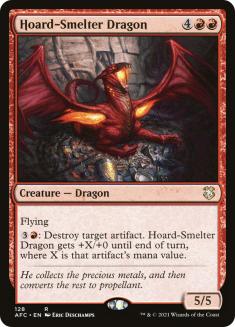
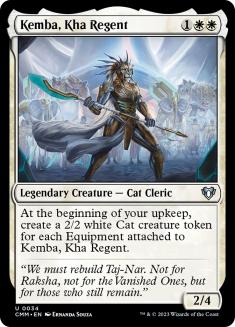
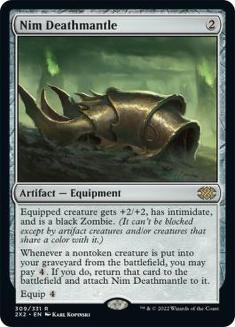
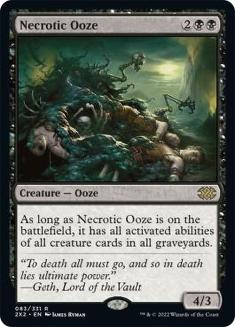
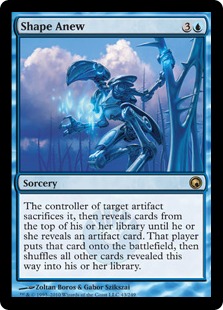
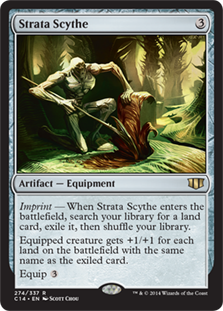
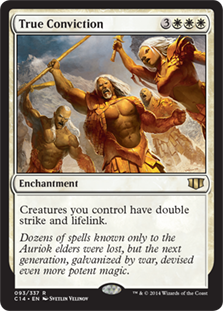
The following Scars of Mirrodin bulk rares are generally not tradable:
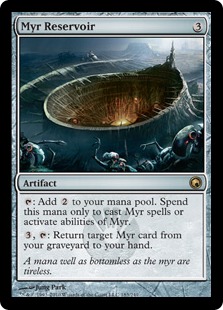
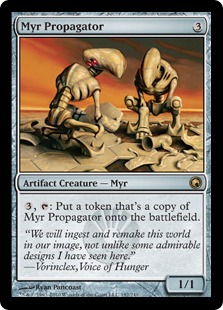
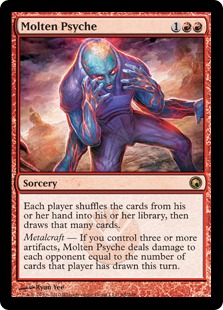
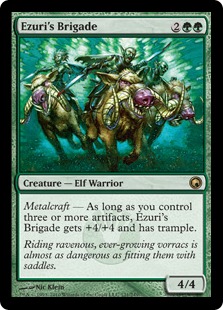
If you don’t know or care about casual cards, don’t worry about it—you won’t make or break your collection buy with these fifty-cent cards, and you can feel free to buylist them all.
If you do sort your bulk rares, put the “true bulk” aside. If you’re making instant collections, you’ll need them for that. Otherwise, bring them to an event and buylist them for as close to $0.15/card as you can get. Put the tradable bulk rares in with the tradable commons and uncommons for now. We’ll get to all of that in a bit.
Finally, it’s time to tackle the money cards. After putting aside the cards that you’re going to keep for yourself, decide what you’re going to do about the rest of them. If you’re going to trade them, you probably already have a binder system set up that works, so I won’t go into any more detail about that.
If you’re going to sell them, decide if you’re going to go the buylist or individual sales route. Buylisting is easier, but your margin is going to be razor thin unless you basically stole the collection. If you’re going individual sales, you’re going to have a lot of listing and shipping in your future, so buckle up.
If you’re buylisting, sort the money cards alphabetically by set—this is how nearly every buylist is set up to receive boxes of cards. If you’re listing online, I prefer sorting by color by set because it’s more intuitive to pull orders. If you are selling them individually, cull any card that doesn’t list for at least $2.50 on StarCityGames.com and put it in the pile of tradables that you haven’t tackled yet. These cards just aren’t worth your time to sell one at a time.
Now it’s time to tackle the last pile. None of these cards should book over $2, but none of them should be valued at less than $0.50, either. Sort these into boxes by “tier”—$0.50 cards, $1 cards, $2 cards, etc.—and trade out of them. Try to “trade up” toward cards that sell better online. Casual players love digging through these random boxes, and I’m never picky with what I take back as long as I can move the new cards easier. After the boxes get picked over, I buylist the leftover cards for the $0.05–$0.75 each that they sell for. This is also what I do with the cards that don’t sell online after several weeks.
As you can see, flipping collections can be profitable, but it takes a lot of time and effort. If you like sorting cards while watching television in the evening, it’s a pretty sweet second job. If this all sounds horrible to you, there are certainly some easier ways to make money. Of course, you haven’t really lived until you’ve bought a full set of Power in an empty parking lot at night. It’s like Breaking Bad, but legal and marginally less scary.
This Week’s Trends
– I’m still bullish on Craterhoof Behemoth. The card is tearing up the online metagame at the moment, and the paper price keeps sneaking up. The Hoof could hit $10 again.
– Remember when everyone was saying that the days of Deathrite Shaman under $20 were numbered thanks to all of the Modern and Legacy play that it sees? Well, it’s still just as dominant, but it’s down to $12. I still think it’ll dip a bit this summer, but if it goes much lower, I’m going to buy in.
– Liliana of the Veil still keeps going up, but I think she’s very close to her all-time peak. Sell.
– Marrow-Gnawer has proven that its price increase wasn’t just market manipulation. It is now a very real $10+ casual rare and should be treated as such.
– The floor is very, very close to dropping out on Thundermaw Hellkite.
– Today is opening day in Major League Baseball. Go Red Sox!
Until next time –
– Chas Andres
